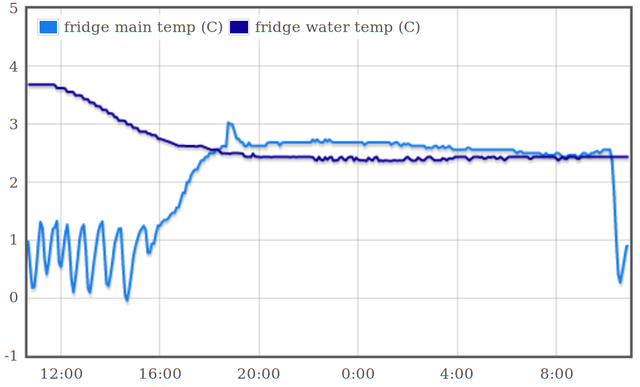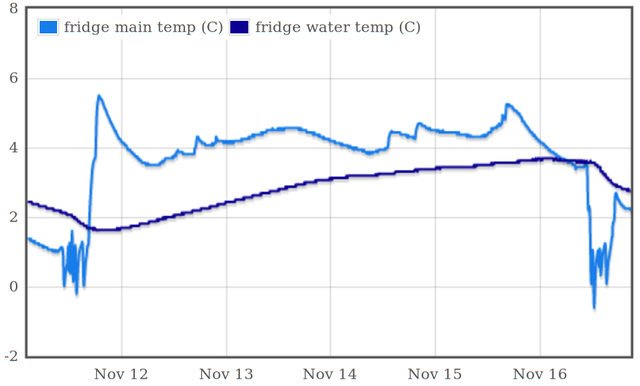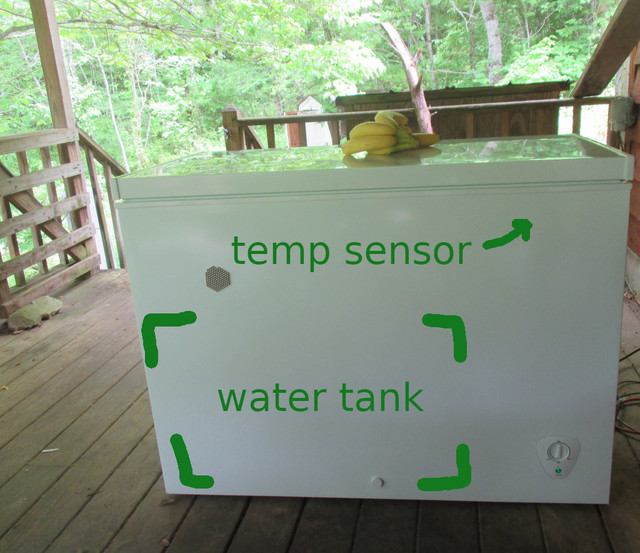Thermal mass is an important component of fridge0, because it helps to turn the chest freezer into a "cold battery".
During the day, fridge0 runs whenever there's sufficient solar power and the groceries are not too cold -- don't want to freeze them. This slowly pulls down the temperature of the thermal mass. In this example, the fridge ran for 2 hours over the course of the day, and the thermal mass was cooled down by 1.3C.
Fridge0 often stops running before the last meal of the day, and so it will often be opened several times and perhaps some warm leftovers put into it. This causes the air in the fridge to spike up, but its temperature will then trail back off as the thermal mass cools it back down. Such spikes and recovery can be seen in the graphs above and below.
When the fridge is unable to run for a period of several days, the thermal mass slowly warms up, moderating the temperature of the air and groceries in the fridge. In the above example, the fridge didn't run for 4 days, and the thermal mass warmed up by 2C over that time, and kept the food safely cool. (Temperatures outside the fridge ranged from 4-13C.)
The other thing thermal mass can do, during the winter, is keep the food from freezing when the fridge is located outdoors, by helping to average out the daily temperature swings. Of course this won't work if your area averages below freezing for too long a period of time.
sizing
The thermal mass should be large enough to keep the fridge cool for however many days it may need to last without running. Three or four days would be a good design goal. If in doubt, make it too large -- a cold battery made from water is cheap!
composition
Water is the easy choice.
A material that can be frozen would be better, because it takes a lot of extra heat to melt a frozen material and so more cold could be stored.
However, this needs a material that freezes at a higher temperature than water, and most such are oils, which are less dense and so store less cold overall.
This is an open research area.
location
It would be good to put the thermal mass above the food, so warm air would go up to it and cool down but that's probably impractical.
The walls of a chest freezer get quite cold while it's running, which could damage sensitive food that's directly exposed to them. So putting the thermal mass in between such food and the walls would be a good idea.
If the thermal mass is located on the bottom of the fridge, air will tend to be progressively warmer above it to the lid. So it's a good idea to have an area lower down for food like milk and meat that needs to stay especially cold. Higher areas of the fridge can be used for eg vegetables.
Joey Hess's fridge0
I found some plastic tubs that fit into my fridge well, and filled them with water.
The thermal mass is 17 gallons in size.
It uses around 1/3rd of the space in my 8.7 cubic foot chest freezer.
The water tubs don't cover the whole bottom of the fridge, so there's a "cold well" next to them. I put milk, down there, and cold drinks. Meats sit on the shelf above the compressor, below the top of the thermal mass, where the air is colder.
During the summer, my fridge's thermal mass often gets cooled down very close to 0C during the day. It, and drinks in the cold well often get a bit of ice in them, but never freeze entirely.
I also use a small amount of peanut oil (half a gallon), which does freeze and thaw at a useful temperature (2 to 4C), but I am unsure how effective it is due to its light weight.
others
Please add your thermal mass here if you do a fridge0 build.



Water additives can dramatically alter the amount of thermal capacity water has. I'm a huge fan of the Cooler Shock ice packs - they ship them dry and you add water to them. The 0c ones really are a replacement for dry ice if you freeze them in a sufficiently cold freezer for at least 48 hours.
https://coolershock.com
I dunno if they would be as effective at refrigerator temperatures since they are aimed for frozen use, but it would be interesting to see if there are different additives that might help enhance the inherit capabilities of water.
HI, thermal battery is a great idea! I must try it
As you have written, freezing water could store ~10x the heat. If it is possible to store the ice below the food, several centigrades under 0 C wont freeze the food because the thermal gradient in the box!?
You can't raise the freezing point of water above 0°C with additives. You can get almost a tenth of a degree wiggle room by lowering air pressure, but it would require a fair bit of energy to maintain.
Vegetable oils are a surprisingly good alternative if cost is not an issue. Pure water is near 1g/cm3, and most vegetable oils clock in between 0.91~0.93g/cm3, so you can get equivalent mass without too much added volume. As an example, 18.10 gallons of peanut oil provides the same thermal mass as 17 gal water.
What I don't know is the effective "duty cycle", or how long they would remain stable after repetitive phase change over an extended time. It might be useful to track your gallon of peanut oil over time.
I'm following your lead and building a very similar off-grid fridge, the only significant difference is I'll be controlling it with micropython code running on an esp32 microcontroller.
Thanks so much for the inspiration, and also thank you for your work on debian, git-annex and so many other great projects you've contributed to.
https://hackaday.io/project/170859-upyfridge0